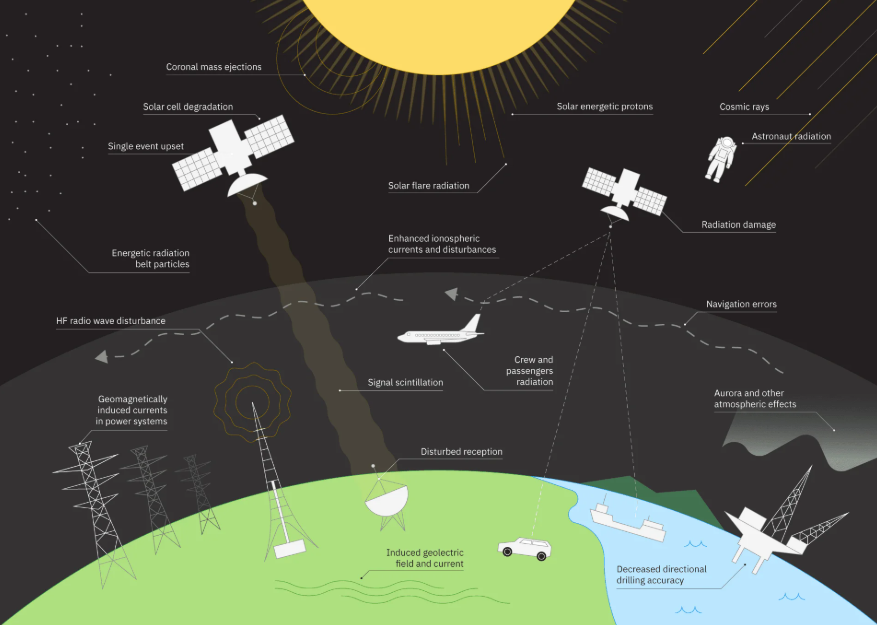IBM Corp. said today it’s teaming up with experts from the National Aeronautics and Space Administration to create an artificial intelligence model that can provide an early warning about solar flares and coronal mass ejections that could cause serious disruption to life on Earth.
The new open-source model, called Surya, named after the Sanskrit word for “sun,” is available to download on Hugging Face. IBM said it’s designed to interpret high-resolution solar images so it can forecast space weather conditions and help protect satellites in low-Earth orbit, power grids, telecommunications systems and other infrastructure that could be severely affected by strong solar flares.
Scientists know only too well how damaging solar flares can be. Although the sun is about 93 million miles away, such events can knock out satellites, disrupt airline navigation and take energy grids offline, and they also pose major radiation risks to any astronauts who happen to be in orbit.
Although these incidents are rare, they do happen. A case in point is the so-called “Carrington Event” in September 1859, which was a massive solar storm caused by a powerful coronal mass ejection from the Sun, directed at Earth. The flare was observed by the British Astronomer Richard Carrington 17 hours before the event, and resulted in spectacular auroras visible as far south as the Caribbean.
It led to severe disruption of telegraph systems worldwide, causing operators to receive electric shocks and equipment to catch fire. There was even a report of two telegraph operators who shut down their systems, but were still able to communicate with one another given the electrical current in the atmosphere caused by the aurora.
One study by Lloyd’s suggests that if a similar event occurred today, it would likely cause extensive damage to electrical grids, satellites and communication systems, with economic losses estimated at about $2.4 trillion.
There have been plenty of close calls in recent years. Less severe solar storms hit Earth in 1921 and 1938, causing massive radio disruption, while the March 1989 geomagnetic storms took down power grids in large parts of Quebec, Canada. Another “Carrington-class” solar storm occurred in July 2012, but its trajectory missed the Earth by a margin of just nine days.

With humanity becoming increasingly dependent on space-based technology and focused on further exploration of the solar system, it’s essential to be able to predict the behavior of the sun, and that’s exactly what Surya has been designed to do. If experts can accurately forecast a solar flare, they might be able to shut down at-risk infrastructure systems and prevent damage from being done to them.
Space weather forecasting
Current solar weather prediction relies on partial satellite views of the Sun’s surface, but Surya significantly improves on this. It’s trained on the world’s largest and highest-resolution heliophysics dataset, which was created to help researchers study and evaluate space weather prediction tasks. Some example tasks, which Surya was trained on, include solar flare prediction, solar EUV spectra forecasting, the speed of solar winds and the emergence of active regions on the Sun’s surface.
IBM’s and NASA’s researchers say early tests show that Surya has achieved a 16% improvement in the accuracy of solar flare classifications. They intend to continue training the model to visually predict solar flares for the first time, with the aim being to provide a two-hour warning before such events take place.
IBM Research Europe Director Juan Bernabe-Moreno said Surya will provide weather forecasts for the sun. “Just as we work to prepare for hazardous weather events, we need to do the same for solar storms,” he explained. “Surya gives us the unprecedented capability to anticipate what’s coming and is not just a technological achievement, but a critical step toward protecting our technological civilization from the star that sustains us.”
Surya was reportedly trained on more than nine years’ worth of high-resolution solar observation data from the NASA Solar Dynamics Observatory. The images are about 10 times larger than typical images used for AI training, so IBM had to develop a customized multi-architecture system to handle the increased spatial resolution. That’s needed to resolve solar features with enough detail and context to try and understand what’s happening.

NASA Chief Science Officer Kevin Murphy said the combination of its deep scientific expertise and powerful AI is extremely promising for data-driven science. “By developing a foundation model trained on NASA’s heliophysics data, we’re making it easier to analyze the complexities of the Sun’s behavior with unprecedented speed and precision,” he said. “This model empowers broader understanding of how solar activity impacts critical systems and technologies that we all rely on here on Earth.”
Holger Mueller of Constellation Research Inc. said the model is a good example of where AI doesn’t just replace humans, but does jobs that most humans cannot do. “Very few people in the world have the skills to even attempt to forecast solar weather, so AI changes the dynamic,” the analyst said.
Additionally, Mueller said the partnership between IBM and NASA shows how organizations can work together to continuously advance AI. “We have one partner with all of the data, and the other has the know-how and systems in place to build the models, and we will see many more of these kinds of partnerships in all areas.”
Surya is just the latest initiative in a long-running collaboration between IBM and NASA. Two years ago, they teamed up to create an AI model that’s designed to analyze geospatial satellite imagery at unprecedented scale. It’s one of the most powerful models within the Prithvi family, and is all about forecasting Earth-based risks, such as flooding and wildfires. Like Surya, it was open-sourced and made available on Hugging Face for the benefit of the broader research community.
Last year, IBM and NASA released a second Prithvi model designed to provide short- and long-term weather projections and forecast climate change.
Images: SiliconANGLE/Dreamina AI, IBM/NASA
Support our mission to keep content open and free by engaging with theCUBE community. Join theCUBE’s Alumni Trust Network, where technology leaders connect, share intelligence and create opportunities.
15M+ viewers of theCUBE videos, powering conversations across AI, cloud, cybersecurity and more
11.4k+ theCUBE alumni — Connect with more than 11,400 tech and business leaders shaping the future through a unique trusted-based network.
About SiliconANGLE Media
Founded by tech visionaries John Furrier and Dave Vellante, SiliconANGLE Media has built a dynamic ecosystem of industry-leading digital media brands that reach 15+ million elite tech professionals. Our new proprietary theCUBE AI Video Cloud is breaking ground in audience interaction, leveraging theCUBEai.com neural network to help technology companies make data-driven decisions and stay at the forefront of industry conversations.

